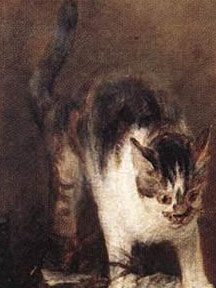
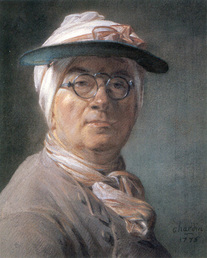
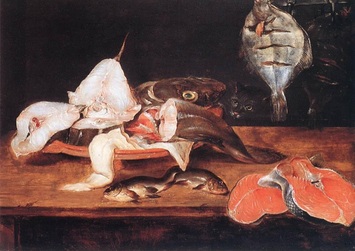
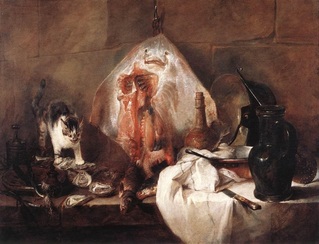
(Click on the image for a larger view.)
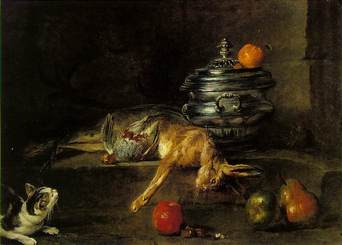
(Click on the image for a larger view.)
| artsmarttalk.com |
|
 Detail from 'The Ray' by Chardin _ Cats, like children, are hard to include in serious art - too cute. For a change from the modern art of the last two posts, here's some 'serious' historical art that happens to include cats, by one of my favorites. I like cats - I have two - and I'm very fond of the artist Jean-Baptiste Simeon Chardin. Born in Paris in 1699, Chardin grew up and spent his life within the city walls without much need or thought for travel beyond. Once he caught the attention of King Louis XV he was granted a studio in the Louvre and lived there until his death in 1779. (At the time the Louvre was an abandoned royal residence being used for artisan workshops and meeting places for the artistic and scientific academies founded by Louis XIV - Chardin went regularly to meetings of the arts academy after he became a member.)  Self Portrait with Eye Shade 1775 _ Chardin was a true local artist, mostly self-taught but smart and observant - and a quiet revolutionary. In contrast to the grandiose Rococo art that is the signature of the period, Chardin took his cue from the deceptively simple Dutch still life tradition. The golden age of Dutch Baroque painting was drawing to an end, but masterful examples of composition, virtuosic effects of light and texture, and the rich possibilities of a simple story told with style and close attention to detail would have been easy for Chardin to find.  Still Life with Fish by Adriaenssen 17th c _ 'Deceptively simple' is a good phrase to keep in mind for Dutch still lifes as well as for the work of Chardin - there is far more than meets the eye. Many Dutch still lifes feature grandiose settings of lavish expensive foods and exquisite vessels of glass, silver, and brass - they do double duty in celebrating the enormous prosperity of Holland during the 17th century, while also paying homage to the simple pleasures of life, free of tyranny by church or king (many contain intricately coded messages, but that's a complicated subject for another post.) This example by Alexander Adriaenssen, who died shortly before Chardin was born, is somewhat atypical of Dutch still life, but a close match for Chardin. The concentration of raw foods anticipate the feast to come, inviting us behind the scenes to identify with the simpler folk who will do the work of preparation for the 'upstairs' party, while shooing away the cat (look closely) from tempting pile of fresh fish.  The Ray by Chardin 1728 _ Chardin's revolution was a similar peek behind French aristocratic grandiosity, gently (and probably unconsciously - he was no outright rebel) guiding thoughts to a democratic future that would soon slap France hard across its rouged and powdered face. 'The Ray' from 1728 was one of several early paintings that gained him admission to the Academy. I've always found it to be one of his most interesting stories in paint. There are messages here of life and death, cruelty and comfort. Note the cat (really a kitten) - cute at first glance but with the demonic leer of a killer intent on prey, and in contrast the strange 'face' of the eviscerated ray that evokes a sad commedia del arte clown. The knife - an instrument of death - and the pitcher - a container for water, the stuff of life - hover just at the edge of the table, a precarious position that may be there to remind of us the precariousness of existence. (Click on the image for a larger view.)  The Silver Tureen by Chardin 1728 _ 'The Silver Tureen' also by Chardin, also from 1728, also with a cat, seems a meditation on life, with the cat sitting quietly staring into the blank eyes of his fellow creatures , seeming to question the whimsy of fate. (Click on the image for a larger view.)
0 Comments
Leave a Reply. |
Share ArtSmartTalk
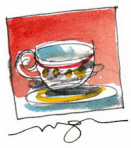
MacGregor-Art.com Cards and art gifts with a Fine Sense of Fun Also at http://www.etsy.com/shop/MacGregorArt ArtSmart Consulting
|
| Blog: |
| ArtSmartTalk |
Topics: |
| Art History, Design, Art |
All
19th C Art4a3f8ec7db
20th C59300e1f29
African Art
Almutanabbi Streetbb1c3786e2
American Art
Ann Hamilton
Apple
Apple Computers
Arabic Poetry
Architecture
Art
Art And Nature
Art And Technology
Art As Collective Memory
Art Auctions
Art Books
Art Forgery
Art Galleries
Art History
Art In Gardens
Art Installation
Art Installations
Art Licensing
Art Of Spain
Art Prints
Art Technology
Baghdad Books
Barnes Collection
Biennial
Book Project
Books
Brooklyn Museum
California Design
Chelsea Galleries
Chess
Color
Constable
Contemporary Architecture
Contemporary Art
Contemporary Design
Design
Detroit Institute Of Arts
Drawing
E H Shepard
El Anatsui
Etching
European Art
Expressionism
Fabric Design
Flags
Folk Art
French Art
French History
French Portraits
Galleries
George Bellows
Goya
Goya Black Paintings
Goya Portrait
Hand-made Books
Historical Art
Hokusai
Ho Tanner
Illustration
Installation Art
Iraq
Jean Clouet
Lacma
Lewis Chessmen
London
Los Angeles
Mac Computers
Mary Cassatt
Matisse
Met Museum
Metropolitan Museum
Metropolitan Museum Of Art
Modern Art
Modern British Painting
Moma
Moma Ps1
Moons
Museums
Napoleon
National Gallery
Nature
New Architecture
New Art
New Design
New Goya Painting
New York
New York Art
Norse Art
Novels About Art
Old City Philadelphia
Online Art Sites
Outdoor Art
Outsider Art
Painting
Paris
Pat Steir
Performance Art
Philadelphia
Philadelphia Art
Philadelphia Museum
Photography
Plein Air
Portraits
Product Design
Red
Religious Art
Rembrandt
Rome
Rothko
Royal Portraits
Sarah Sze
Scottish Art
Self-portraits
Significance Of Art
Sketching
Southern California
Soutine
Spanish Art
Spanish History
Steve Jobs
Technology
Thanksgiving
The Importance Of Art
Turner
Van Gogh
Velasquez
Venice Biennale
Whitney Museum
Words And Art
Young Artists
August 2013
May 2013
February 2013
January 2013
December 2012
November 2012
October 2012
September 2012
August 2012
July 2012
June 2012
May 2012
April 2012
March 2012
February 2012
January 2012
December 2011
November 2011
October 2011
September 2011
August 2011
July 2011